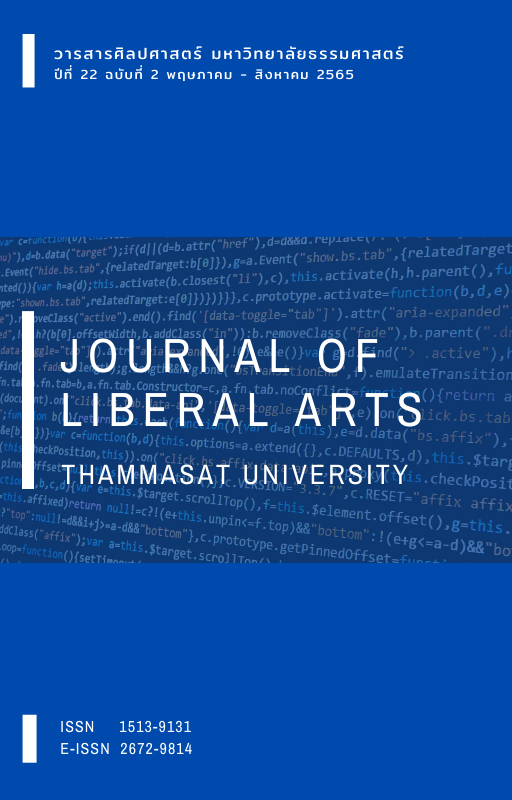Quranic Geminate Consonants in Tajweed Rules: The Acoustic Phonetic Study of Timing
Main Article Content
Abstract
This research aims to study the durational property of Quranic consonant gemination in Quran recitation, which includes the mean value of each gemination, the mean value of each gemination in word positions, and the mean value of each gemination preceding vowels. Such gemination is based on Tajweed rules, the principle of pronunciation that Quran readers have to strictly follow. Consonant gemination, or long consonants, is considered a distinct feature in Arabic (one of the Semitic language families) which affects the syntactic structures and meaning of a term. The gemination according to Tajweed in Quran recitation does not change those features and meaning, but makes the Quran reading more rhythmic, accurate, and pleasant to hear. The research reveals that nasal consonants [m:, n:] have the longest duration and voiceless stops [t:, k:] have the shortest. The findings also show that the geminations of nasals, approximants, and trills in different positions within a word differ statistically. This difference also applies to the gemination of fricatives that precede a vowel. Finally, the results of the study prove that consonant gemination according to Tajweed is unique and differs from the Arabic gemination standard. The findings shed light on the understanding of the Tajweed principle and the learning of standard Arabic and Quranic Arabic reading.
Downloads
Article Details

This work is licensed under a Creative Commons Attribution-NonCommercial-NoDerivatives 4.0 International License.
References
นดีม หะซะนี. (2556). ตัจวีดกะลามิรเราะฮ์มาน. กรุงเทพมหานคร.
สราวุฒิ ไกรเสม และ ยูเนียนสาสมีต้า สาเมาะ (2564). พยัญชนะเสียงยาวภาษาอาหรับในการอ่าน อัลกุรอาน: การวิเคราะห์ทางสัทวิทยาอัตภาค. วารสารมนุษยศาสตร์มหาวิทยาลัยนเรศวร, 18(3). 106-128.
สะอัด วารีย์. (2562). ตัจญ์วีดแบบง่าย. dasee. http://www.daasee.com/index.php
อับดุลอาซิซ สิเดะ และ ซาฟีอี อาดํา. (2558). การประทานและการรวบรวมอัลกุรอาน. วารสาร AL-NUR บัณฑิตวิทยาลัย, 2(10), 167-179.
Abramson, A. S. (1986). The perception of word-initial consonant length: Pattani Malay. Journal of the International Phonetic Association, 16(1), 8-16. doi:10.1017/S0025100300003054
Abramson, A. S. (1987). Word-initial consonant length in Pattani Malay. Proceedings of the 11th international congress of phonetic science, 6, 68-70.
Abramson, A. S. (1991). Amplitude as a cue to word-initial consonant length: Pattani Malay. Proceedings of the 12th International Congress of Phonetic Sciences, 3, 98-100.
Abramson, A. S. (2003). Acoustic cues to word-initial stop length in Pattani Malay. Proceedings of the 15th International Congress of Phonetic Sciences, 387-390.
Al-Ani, S. H. (1970). Arabic phonology: An acoustical and physiological investigation. Mouton.
Alsurf, S. (2012). The phonetics of Qur’ānic pharyngealised sounds: Acoustic and articulatory studies [Unpublished doctoral dissertation]. Macquarie University.
Al-Tamimi, F. Y. (2004). An experimental phonetic study of intervocalic singleton and geminate sonorants in Jordanian Arabic. Al-Arabiyya, 37-52.
Chang, W. (2000). Geminate vs. non-geminate consonants in Italian: evidence from a phonetic analysis. University of Pennsylvania Working Papers in Linguistics, 7(1), 53-63.
Embarki, M. (2013). Phonetics. In J. Owens (Ed.), The Oxford handbook of Arabic linguistics (pp. 23-44). Oxford University Press. doi:10.1093/oxfrodhb/9780199764136.013.0002
Goldsmith, J. A. (1990). Autosegmental & Metrical Phonology. Basil Blackwell.
Hamzah, H. (2013). The acoustics and perception of the word-initial singleton/geminate contrast in Kelantan Malay [Unpublished doctoral dissertation]. University of Melbourne.
Kawagoe, I. (2015). The phonology of sokuon, or geminate obstruents. In H. Kubozono (Ed.), The Handbook of Japanese Phonetics and Phonology (pp. 53-66). De Gruyter Mouton.
Kawahara, S. (2015).The phonetics of sokuon, or geminate obstruents. In H. Kubozono (Ed.), The Handbook of Japanese Phonetics and Phonology (pp. 43-78). De Gruyter Mouton.
Kaye, A. J. (2009). Arabic. In B. Comrie (Ed.), The world's major languages (pp. 560-577). Routledge.
Khattab, G. (2008).A phonetic study of gemination in Lebanese Arabic. 16th International Congress of Phonetic Sciences, 153-158. www.icphs2007.de
Khattab, G., & Al-Tamimi, J. (2014).Geminate timing in Lebanese Arabic: The relationship between phonetic timing and phonological structure. Laboratory Phonology, 5(2), 231-269. doi:10.1515/lp-2014-0009
Kubozono, H., Takeyasu, H., & Giriko, M. (2013). On the positional asymmetry of consonant gemination in Japanese loanwords Journal of East Asian Linguistics, 22(4), 339-371.
Ladefoged, P., & Maddieson, I. (1996). Sounds of the world's languages. Blackwell.
Lahiri, A., & Hankamer, J. (1988). The timing of geminate consonants. Journal of Phonetics, 16, 327-337.
Ohala, M. (2007). Experimental methods in the study of Hindi geminate consonants. In P. Beddor, M.-J. Solé & M. Ohala (Eds.), Experimental Approaches to Phonology (pp. 351-368). Oxford University Press.
Paramal, W. (1991). Long consonants in Pattani Malay: The result of word and phrase shortening [Unpublised master's thesis]. Mahidol University.
Rohman, S. (2552). ตัจญ์วีดเบื้องต้น. https://basictajweed.wordpress.com
Yeni-Komshian, G. H., Caramazza, A., & Preston, M. (1977). A study of voicing in Leabnese Arabic. Journal of Phonetics, 5, 35-48.

